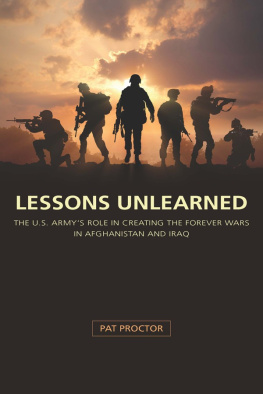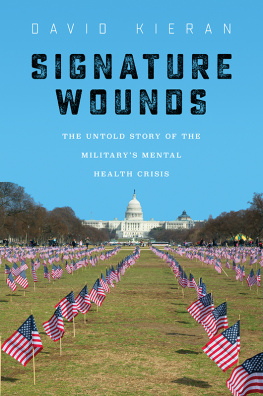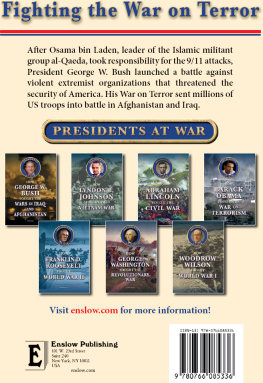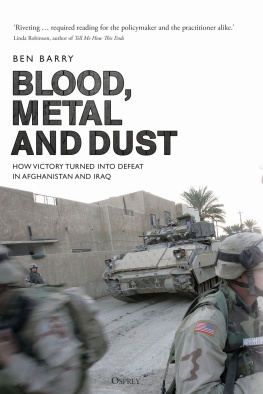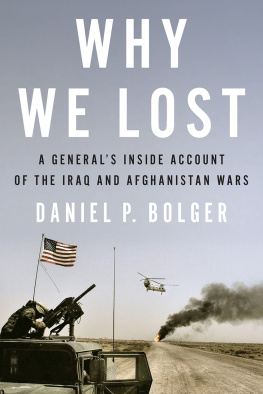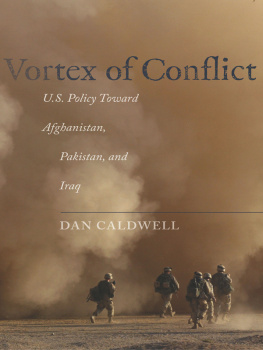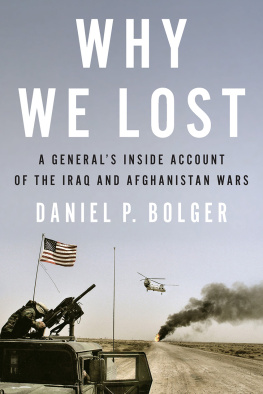LESSONS UNLEARNED
Copyright 2020 by The Curators of the University of Missouri
University of Missouri Press, Columbia, Missouri 65211
Printed and bound in the United States of America
All rights reserved. First printing, 2020.
Library of Congress Cataloging-in-Publication Data
Names: Proctor, Pat, 1971- author.
Title: Lessons Unlearned : the U.S. Armys role in creating the forever wars in Afghanistan and Iraq / Pat Proctor.
Other titles: U.S. Armys role in creating the forever wars in Afghanistan and Iraq
Description: Columbia : University of Missouri Press, 2020. | Series: American military experience | Includes bibliographical references and index.
Identifiers: LCCN 2019034808 (print) | LCCN 2019034809 (ebook) | ISBN 9780826221940 (hardcover) | ISBN 9780826274373 (ebook)
Subjects: LCSH: Low-intensity conflicts (Military science)--United States. | United States. Army--Organization--Evaluation. | United States. Army--Operational readiness--Evaluation. | United States--History, Military--Case studies. | Intervention (International law)--Case studies. | Low-intensity conflicts (Military science)--Case studies. | Military doctrine--United States. | Strategy--United States.
Classification: LCC U240 .P765 2020 (print) | LCC U240 (ebook) | DDC 355.02/180973--dc23
LC record available at https://lccn.loc.gov/2019034808
LC ebook record available at https://lccn.loc.gov/2019034809

This paper meets the requirements of the American National Standard for Permanence of Paper for Printed Library Materials, Z39.48, 1984.
THE AMERICAN MILITARY EXPERIENCE SERIES
JOHN C. MCMANUS, SERIES EDITOR
The books in this series portray and analyze the experience of Americans in military service during war and peacetime from the onset of the twentieth century to the present. The series emphasizes the profound impact wars have had on nearly every aspect of recent American history and considers the significant effects of modern conflict on combatants and noncombatants alike. Titles in the series include accounts of battles, campaigns, and wars; unit histories; biographical and autobiographical narratives; investigations of technology and warfare; studies of the social and economic consequences of war; and in general, the best recent scholarship on Americans in the modern armed forces. The books in the series are written and designed for a diverse audience that encompasses nonspecialists as well as expert readers.
Selected titles from this series:
Military Realism:
The Logic and Limits of Force and Innovation in the US Army
Peter Campbell
Loss and Redemption at St. Vith
The 7th Armored Division in the Battle of the Bulge
Gregory Fontenot
Omar Nelson Bradley: Americas GI General, 18931981
Steven L. Ossad
The First Infantry Division and the US Army Transformed:
Road to Victory in Desert Storm, 19701991
Gregory Fontenot
Dick Coles War: Doolittle Raider, Hump Pilot, Air Commando
Dennis R. Okerstrom
For Major Rob Olson, the last fallen soldier of the Cold War.
LIST OF FIGURES
ACKNOWLEDGMENTS
A PROJECT OF this scale does not happen without the help of a great many people. I have done my best to mention all who contributed to this work in meaningful ways, but I am certain to have overlooked some of those who helped me. To those persons I apologize in advance.
I will begin by thanking the Department of History at Kansas State University for graciously honoring me with a James C. Carey Fellowship; the resources the fellowship provided were invaluable in my completing this work. I would especially like to thank Don Mrozek, whose wise counsel and advicenot only in the early stages of the book but throughout my academic careerprofoundly influenced the shape this book ultimately took.
I would also like to thank a number of people at the U.S. Army War College for their help. Jim Kievit and Chris Mason offered keen insights; my many discussions with them as well as with Larry Goodson and Brett Weigle, both of whom helped me conceptualize this project, helped me immensely. Likewise, my frequent discussions with Conrad Crane; I cant thank him enough for giving so generously of his time and in sharing his views with menot to mention hunting down so many helpful documents and resources for me. I found the advice of and reviews by Tony Echevarria helpful as I began this work. I also benefited from my many discussions with the members of Seminar 16especially Col. Santosh Dhakal, Col. Chris Hackler, and Col. Maurice Sipos.
The staffs of the libraries and archives connected with the U.S. Army War College made valuable contributions. I would especially like to thank Gail Silkett at the U.S. Army War College Library and Rich Baker, Tom Buffenbarger, Steve Bye, Rodey Foytik, and Shannon Schwaller at the archives of the U.S. Army Heritage and Education Center. The service all of you provide to our Army is indispensable, if underappreciated.
The team at the U.S. Army Peacekeeping and Stability Operations Institute provided much-needed assistance. My special thanks here go to Col. Jay Liddick, whose feedback was very important as I wrote the first draft, and the assistant director, William J. Flavin, for his assistance.
I also wish to thank a number of people at the U.S. Army Command and General Staff College at Fort Leavenworth, Kansasin particular, the Department of Military History for pointing me toward great resources, listening to my ideas, and providing invaluable feedback. Special thanks go to Geoff Babb, Tom Hanson, Sean Kalic, and Jim Willbanks for their time and assistance.
Several others at Fort Leavenworth made important contributions to this work. Michael Browne and Elizabeth Dubuisson at the Ike Skelton Combined Arms Research Library came to the rescue and were incredibly helpful filling in some important last-minute gaps in my research. I would also like to thank Brad Cox and Kelvin Crow for the important work they do at the U.S. Army Combined Arms Center History Office in preserving and archiving the history of the U.S. Army.
Numerous other people have my deep gratitude for providing me with materials that proved indispensable. Thank you to Paul Herbert and Andrew Wood at the First Division Museum at Cantigny Park, not only for the materials but for the excellent advice on this book and the service you provide to our Army and our nation. Thanks go as well to Tammy S. Schultz of the Marine Corps War College for her help and her scholarship and to Lynn Gamma and Tammy Horton at the U.S. Air Force Historical Research Agency at Maxwell Air Force Base, Alabama, for helping me find key documents at a critical time.
I would also like to thank a number of former senior Army leaders who gave selflessly of their time as I researched this book: Gen. (Ret.) Eric Shinseki; Gen. (Ret.) Gordon Sullivan; Lt. Gen. (Ret.) James Dubik; Lt. Gen. (Ret.) Jon Riggs; Lt. Gen. (Ret.) Roger Schultz; Brig. Gen. (Ret.) John S. Brown; and Col. (Ret.) John Gingrich. While I am critical in this book of some of your decisions and actions, I know that you always had the best interests of the Army and the nation at heart and I honor your incredible service; your tireless dedication to our nation and its defense is beyond reproach. My thanks to you and to all of the men and women who have served our nation in uniform for your service.
Two people have been instrumental in helping this book to see the light of day. Thank you to Andrew Davidson, editor in chief of the University of Missouri Press, for seeing the value in this work. And a special thanks goes to my literary agent, Grace Freedson. Your tireless effort and faith in me and my work are always a source of inspiration.
 This paper meets the requirements of the American National Standard for Permanence of Paper for Printed Library Materials, Z39.48, 1984.
This paper meets the requirements of the American National Standard for Permanence of Paper for Printed Library Materials, Z39.48, 1984.
